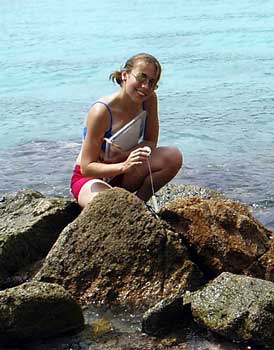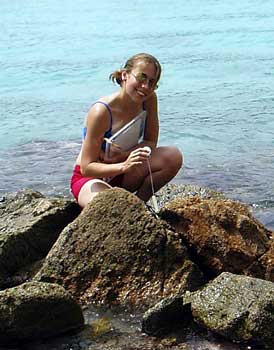 KINGSTON, R.I. — November 8, 2004 — Every day for two months last summer, East Providence resident Grace Lentini walked the shoreline of two Caribbean islands at low tide in search of Caribbean whelks, an endangered snail.
KINGSTON, R.I. — November 8, 2004 — Every day for two months last summer, East Providence resident Grace Lentini walked the shoreline of two Caribbean islands at low tide in search of Caribbean whelks, an endangered snail.
“They’re easy to find, and they’re a very tasty local dish, so people eat them quite frequently,” said Lentini, a senior wildlife conservation and biology major at the University of Rhode Island. “That’s part of the reason why they’re endangered.”
The shoreline surveys are the first step in assessing the population status of the whelk, which lives on the Virgin Islands, Cuba and parts of the Dominican Republic and can grow as large as a grapefruit.
“We’re trying to find out about their basic biology to prevent potential extinction,” Lentini said. “We collected baseline data on 2,000 whelks, including population information, growth rates, where they’re found, how dense they are in certain areas, and how long they live.”
Lentini spent a month on pristine Guana Island, a privately owned island in the British Virgin Islands, and another month on neighboring Tortola, which has been significantly impacted by its large human population.
“The most obvious thing we found was that there were far fewer whelks on
Tortola than on Guana, most likely from people taking them,” said Lentini, whose research was conducted in collaboration with URI Professor Graham Forrester. “I’m now analyzing each site to see if habitat location may influence abundance or size. The sheltered sites seemed to have more whelks, but the exposed sites had larger ones.”
Lentini was impressed with the whelk’s defense mechanisms. She said that many of the whelks would notice her walking up to them and drop from a rock into the water to escape from being captured. The larger whelks had the remarkable ability to remain secured to the rocks despite the URI student’s efforts to remove them. To take proper measurements, she often had to use a metal file to pry them off.
What surprised her most, however, was how cute they were.
“I never thought a snail could be cute, but when they come out of their shells with their antennae sticking up, they’re definitely cute,” she said with a smile. “I was sort of surprised that I found the snails as interesting as I did.”
After finishing her daily whelk survey, Lentini helped Forrester collect data on the impact a ship’s anchor had on a local coral reef or assisted URI Ph.D. student Rachel Petrik-Finley on her research into host-parasite interactions of a small reef-dwelling fish called a goby.
Funding for Lentini’s research was provided by the National Science Foundation and the URI Coastal Fellows Program, a unique program designed to involve undergraduate students in addressing current environmental problems. Now in its ninth year, the Coastal Fellows Program teams students with faculty, research staff and graduate students to help them gain skills that will ensure their future success.
When Lentini graduates from URI in 2006 she plans to attend graduate school and eventually earn a Ph.D., though she also wants to take a year off and do longer-term field research.
“I really love studying the population dynamics of species,” she said. “I don’t know yet what species I want to study, I just enjoy finding out what makes a population tick. If it’s in decline, what are the causes of the decline? And if it’s doing well, what is it about it that makes it so successful?
“This was my best summer ever,” Lentini added.

